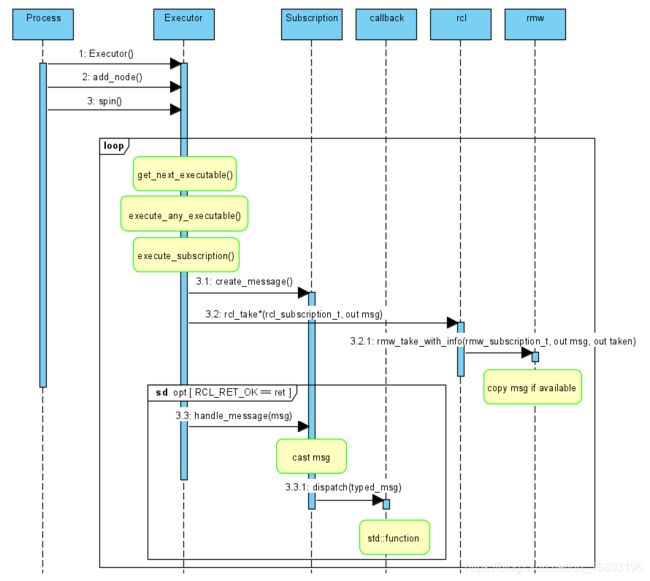ROS2探索(二)executor
前言
在ROS2探索(一)Publisher-Subscriber的内部过程 我们接触了executor这个新东西,发现spin函数其实调用的就是executor的接口,一个executor可以通过add_node来添加多个节点,然后不断循环执行准备好了的AnyExecutable对象。
本文围绕ros2源码中的executors示例,学习下多线程executor,进一步分析executor处理subscription的流程。
正文
打开ros2/examples/rclcpp/executors/下的multithreaded_executor.cpp,直奔main函数:
int main(int argc, char * argv[])
{
rclcpp::init(argc, argv);
rclcpp::executors::MultiThreadedExecutor executor;
auto pubnode = std::make_shared<PublisherNode>();
auto subnode = std::make_shared<DualThreadedNode>();
executor.add_node(pubnode);
executor.add_node(subnode);
executor.spin();
rclcpp::shutdown();
return 0;
}
这里构造了两个节点,PublisherNode和DualThreadedNode,其中DualThreadedNode从名字来看拥有两个线程用来监听话题消息。多线程的节点必须要用MultiThreadedExecutor,这是和之前的不一样的地方。
接下来示例给出了一个进程拥有多个节点的例子,只需要调用add_node添加这些节点即可,添加完了开始spin,不过这里不用给定节点指针对象,因为直接调用的executor.spin:
executor.add_node(pubnode);
executor.add_node(subnode);
executor.spin();
PublisherNode没什么好说的,和前一篇文章中基本一样。直接看DualThreadedNode:
rclcpp::CallbackGroup::SharedPtr callback_group_subscriber1_;
rclcpp::CallbackGroup::SharedPtr callback_group_subscriber2_;
rclcpp::Subscription<std_msgs::msg::String>::SharedPtr subscription1_;
rclcpp::Subscription<std_msgs::msg::String>::SharedPtr subscription2_;
DualThreadedNode拥有两个Subscription成员用于监听同一个话题以及Subscription对应的回调组(CallbackGroup)。
回调组通过Node::create_callback_group进行创建:
callback_group_subscriber1_ = this->create_callback_group(rclcpp::CallbackGroupType::MutuallyExclusive);
callback_group_subscriber2_ = this->create_callback_group(rclcpp::CallbackGroupType::MutuallyExclusive);
参数MutuallyExclusive表示此组的回调函数是互斥的,一次只能同时执行一个。如果配置成CallbackGroupType::Reentrant则同时可以执行多个。
接着创建SubscriptionOptions并设置所属回调组:
auto sub1_opt = rclcpp::SubscriptionOptions();
sub1_opt.callback_group = callback_group_subscriber1_;
auto sub2_opt = rclcpp::SubscriptionOptions()
sub2_opt.callback_group = callback_group_subscriber2_;
然后用这些Options创建Subscription,这里没有用默认参数而是传入了带回调组的SubscriptionOptions:
subscription1_ = this->create_subscription<std_msgs::msg::String>(
"topic",
rclcpp::QoS(10),
std::bind(&DualThreadedNode::subscriber1_cb,std::placeholders::_1),
sub1_opt);
回调函数与之前的lambda表达式不同,这里通过std::bind绑定了成员函数作为作为回调函数,占位符表示回调函数待定的输入。
我们现在重点来看一下rclcpp::executors::MultiThreadedExecutor对象。首先多线程executor的spin函数如下:
void MultiThreadedExecutor::spin()
{
...
std::vector<std::thread> threads;
size_t thread_id = 0;
{
std::lock_guard<std::mutex> wait_lock(wait_mutex_);
for (; thread_id < number_of_threads_ - 1; ++thread_id)
{
auto func = std::bind(&MultiThreadedExecutor::run, this, thread_id);
threads.emplace_back(func);
}
}
run(thread_id);
for (auto &thread : threads)
{
thread.join();
}
}
spin函数中首先根据number_of_threads_创建该数量个std::thread,每个thread绑定run成员函数。run函数与单线程的spin类似,其中增加了线程安全和线程定时器操作。
number_of_threads由用户指定,默认为std::thread::hardware_concurrency()即cpu的核心数,我的输出是8个线程:
![]() 当使用8个线程时,ros2 run examples_rclcpp_multithreaded_executor multithreaded_executor执行后输出如下:
当使用8个线程时,ros2 run examples_rclcpp_multithreaded_executor multithreaded_executor执行后输出如下:
 可以看出节点线程ID不固定,如果将MultiThreadedExecutor的线程数目改为1` :
可以看出节点线程ID不固定,如果将MultiThreadedExecutor的线程数目改为1` :
rclcpp::executors::MultiThreadedExecutor executor(rclcpp::ExecutorOptions(),1);
得到的输出如下: 发现此时三个节点共用了同一个线程。
发现此时三个节点共用了同一个线程。
至此得出以下结论:
- executor有MultiThreadedExecutor和SingleThreadedExecutor两种,MultiThreadedExecutor默认开启CPU核心数个线程
- 每个线程独立地检查executor中已添加节点是否有AnyExecutable,其既可以是publish也可以是subscription
分析完多线程executor的线程创建,我们来看一下executor是执行订阅消息回调的过程。
首先Executor开始spin后每个线程不断循环三个步骤,即下图所示:

其中get_next_executable()调用get_next_subscription()来检查当前是否收到消息
void get_next_subscription(rclcpp::AnyExecutable &any_exec,
const WeakNodeList &weak_nodes) override
{
auto it = subscription_handles_.begin();
while (it != subscription_handles_.end())
{
auto subscription = get_subscription_by_handle(*it, weak_nodes);
if (subscription)
{
// Find the group for this handle and see if it can be serviced
auto group = get_group_by_subscription(subscription, weak_nodes);
if (!group)
{
// Group was not found, meaning the subscription is not valid...
// Remove it from the ready list and continue looking
it = subscription_handles_.erase(it);
continue;
}
if (!group->can_be_taken_from().load())
{
// Group is mutually exclusive and is being used, so skip it for now
// Leave it to be checked next time, but continue searching
++it;
continue;
}
// Otherwise it is safe to set and return the any_exec
any_exec.subscription = subscription;
any_exec.callback_group = group;
any_exec.node_base = get_node_by_group(group, weak_nodes);
subscription_handles_.erase(it);
return;
}
// Else, the subscription is no longer valid, remove it and continue
it = subscription_handles_.erase(it);
}
}
get_next_subscription遍历当前节点的所有rcl_subscription_t句柄,对每个rcl_subscription_t句柄检查其所在回调组是否为MutuallyExclusive,如果是MutuallyExclusive互斥组那么还得确保当前回调没有其他线程正在调用。
得到一个包含subscription的AnyExecutable对象之后,我们执行execute_any_executable中的execute_subscription函数,这个函数很长而且不太容易理解,挑出了关键部分如下:
void Executor::execute_subscription(rclcpp::SubscriptionBase::SharedPtr subscription)
{
rclcpp::MessageInfo message_info;
message_info.get_rmw_message_info().from_intra_process = false;
if (subscription->is_serialized()) //case 1
{
// This is the case where a copy of the serialized message is taken from
// the middleware via inter-process communication.
...
}
else if (subscription->can_loan_messages()) //case 2
{
// This is the case where a loaned message is taken from the middleware via
// inter-process communication, given to the user for their callback,
// and then returned.
...
}
else //case 3
{
// This case is taking a copy of the message data from the middleware via
// inter-process communication.
std::shared_ptr<void> message = subscription->create_message();
take_and_do_error_handling(
"taking a message from topic",
subscription->get_topic_name(),
[&]() {
return subscription->take_type_erased(message.get(), message_info); },
[&]() {
subscription->handle_message(message, message_info); });
subscription->return_message(message);
}
}
execute_subscription有三个分支,他们都是处理经过中间件的消息数据,主要的区别在于:
- case1使用的是序列化的数据,这种消息的header和消息payload是手工设置的,好比TCP定制报文
- case2是向中间件借用消息(loan message),采用的共享内存来避免拷贝,性能不错但需要DDS中间件的支持。这部分先关注,后面文章再谈,先挖好坑。
- case3最简单,直接将消息拷贝一份传给回调函数
我们现在只分析下case3,case3里第一步开辟消息内存:
std::shared_ptr<void> message = subscription->create_message();
然后Subscription对象操作rcl句柄:
rcl_ret_t ret = rcl_take(
this->get_subscription_handle().get(),
message_out,
&message_info_out.get_rmw_message_info(),
nullptr // rmw_subscription_allocation_t is unused here
);
rcl句柄再往下获取rmw句柄的消息:
rmw_ret_t ret = rmw_take_with_info(
subscription->impl->rmw_handle, ros_message, &taken, message_info_local, allocation);
如果rmw_take_with_info返回RMW_RET_OK的话表示rmw有消息,则进行handle_message步骤。
handle_message首先根据模板参数CallbackMessageT将返回数据转换成对应类型:
auto typed_message = std::static_pointer_cast<CallbackMessageT>(message);
然后将带类型的消息数据分发给回调函数进行处理:
any_callback_.dispatch(typed_message, message_info);
完整的handle_message代码如下:
void handle_message(std::shared_ptr<void> &message,
const rclcpp::MessageInfo &message_info) override
{
if (matches_any_intra_process_publishers(&message_info.get_rmw_message_info().publisher_gid))
{
// In this case, the message will be delivered via intra process and
// we should ignore this copy of the message.
return;
}
auto typed_message = std::static_pointer_cast<CallbackMessageT>(message);
any_callback_.dispatch(typed_message, message_info);
if (subscription_topic_statistics_)
{
const auto nanos = std::chrono::time_point_cast<std::chrono::nanoseconds>(
std::chrono::system_clock::now());
const auto time = rclcpp::Time(nanos.time_since_epoch().count());
subscription_topic_statistics_->handle_message(*typed_message, time);
}
}
下面画图总结一下executor的使用与Subscription处理的流程:

总结
本文到目前了解了ROS2的以下内容:
- executor多线程的实现
- 多线程executor默认开启cpu核心数个线程
- CallbackGroup实现了对回调函数的互斥与重入调用
- execute_subscription对于中间件消息有三种处理类型:serialized message、loaded message以及普通的拷贝消息
- executor处理subscription回调的流程
下一篇将分析ros2中的service实现。